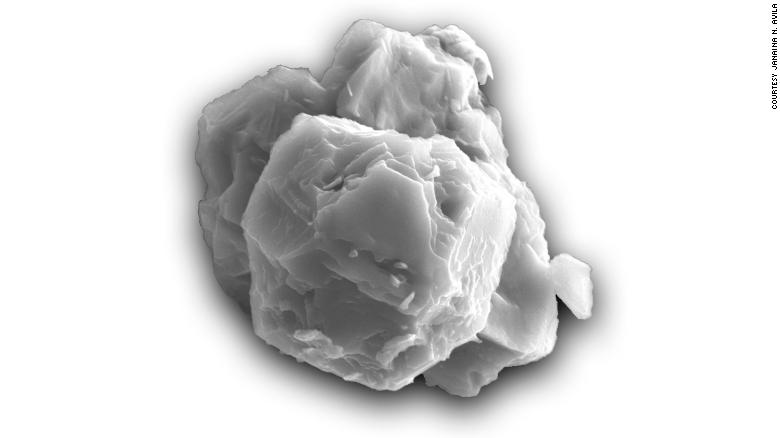- Click to share on Facebook (Opens in a new window)
- Click to share on Twitter (Opens in a new window)
- Click here to share on LinkedIn (Opens in a new window)
- Click to email a friend (Opens in a new window)
Difference between meteorite, meteor, asteroid and comet 1:13
(CNN) - 50 years ago, a meteorite fell to Earth and landed in Australia, carrying with it a rare sample of interstellar space. A new meteorite analysis revealed star dust that formed between 5,000 and 7,000 million years ago. That makes the meteorite and its star dust the oldest solid material ever discovered on Earth.
Our sun is about 4.6 billion years old, which means that this star dust existed long before our sun or solar system was even a reality. Star dust found in the meteorite is known as presolar grains because they formed before our sun.
Stars are born when gas, dust and heat combine in the right way. They can exist for millions or even billions of years before they die and expel their key ingredients into space. This in turn helps new stars to be born, creating a chain of space daisies.
Meteorites, if they don't touch too many things, can act as time capsules of the materials trapped inside them, such as star dust. That is why the discovery of presolar grains is a rarity: only 5% of the meteorites found on Earth contain them. Its incredibly small size is hard to understand.
One hundred of the largest presolar grains found could fit at one point, according to a statement from the Chicago Field Museum.
A new study of Murchison meteorite presolar grains retrieved in Australia published Monday in the Proceedings of the National Academy of Sciences.
"This is one of the most interesting studies I've worked on," said Philipp Heck, lead author of the study and curator at the Field Museum. “These are the oldest solid materials ever found, and they tell us how the stars formed in our galaxy. They are solid samples of stars. ”
Augmented image of a presolar grain or stardust. The grain has a size of approximately 8 micrometers.
The meteorite recovered in 1969 and presolar grains were isolated.
"It starts with fragments of meteorites that turn to dust," said Jennika Greer, co-author of the study and graduate student at the Field Museum and the University of Chicago. “Once all the pieces are segregated, it is a kind of pasta and has a spicy characteristic. It smells like rotten peanut butter. ”
The dissolution of the paste in acid reveals the presolar grains, which allows researchers to determine their age and the type of star to which they belonged.
The researchers were able to measure the exposure of the grains to cosmic rays, highly energized particles that cross our galaxy.
READ : A huge meteorite crashed into the Earth almost 800,000 years ago. We may have finally found the crater
"Some of these cosmic rays interact with matter and form new elements," said Heck. “And the longer they are exposed, the more those elements are formed. I compare this with putting a bucket in a rain storm. Assuming the rain is constant, the amount of water that accumulates in the bucket tells you how long it was exposed. ”
Many of the grains recovered were between 4,600 and 4,900 million years old, while others were more than 5,500 million years old.
They also learned that 7,000 million years ago more stars began to form.
"We have more young beans than we expected," said Heck. “Our hypothesis is that most of these grains, which are between 4,900 and 4,600 million years old, were formed in an episode of improved star formation. There was a time before the start of the solar system when more stars formed than normal. ”
Astronomers have discussed the rate of star formation. Some believe that it is constant and immutable, while others believe that there are peaks and falls.
"Some people think that the galaxy's star formation rate is constant," said Heck. “But thanks to these grains, we now have direct evidence of an improved star formation period in our galaxy 7,000 million years ago with meteorite samples. This is one of the key findings of our study. ”
They also determined that presolar grains have a habit of grouping into groups similar to granola, which they did not believe possible, Heck said.
LEE : NASA astronaut shares beautiful picture of the first meteor shower of 2020
Understanding the grains has shed light not only on the stars and how long their star dust can last, but also on the galaxies and their timelines.
“With this study, we have directly determined the lifespan of star dust. We hope this will be collected and studied so that people can use this as input for models throughout the galactic life cycle, ”said Heck.
“It is very exciting to observe the history of our galaxy. Star dust is the oldest material that has reached Earth, and from it, we can learn about our mother stars, the origin of carbon in our bodies [and] the origin of oxygen we breathe. With star dust, we can track that material until the time before the sun. ”
Meteorite

